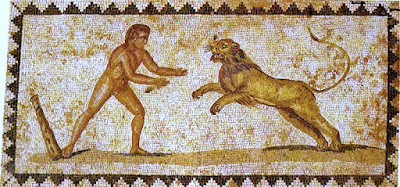 |
| detail from cover of Roman Quest #4 by Paul Young |
There is absolutely no evidence that Boudica, the famous warrior queen of the Iceni, had red hair.
The only archaeological evidence we have for Boudica is a layer of burnt deposits up to half a metre thick in the three British towns she is said to have destroyed in AD 61: Camulodunum (Colchester), Londinium (London) and Verulamium (St Albans). But there is no graffiti that says BOUDICCA WAS HERE. Even in variant spellings of her name such as BOADICEA, BOUDICA (one C) or BUDDUG.
 |
| photo by Caroline, hair colour by Richard |
Even the fabulous Romano-Celtic head (above) that I’ve used to illustrate this article is probably too late to be Boudicca, though it was found near Lactodurum (Towcester), the possible site of her final battle against the Romans.
So no firm archaeological evidence, then.
Our only ancient literary evidence for Boudica is from a few passages in three histories, two by Tacitus and one by Cassius Dio.
The only physical description of her is in the single passage of Cassius Dio, a Roman writing in Greek more than a hundred years after Boudica’s death. This makes it highly unlikely that Dio had an eye-witness. And yet he is the one who gives us the sensational description of her as having a terrifying appearance: tall, fierce in eye, harsh in voice and with long hair down to her waist. He even tells us what she was wearing. Here it is in the original Greek and in translation:
 |
| Dio's description of Boudicca in Greek and English in the Loeb version |
In ancient Greek, if you add the suffix -otatos to a word it means ‘very’ or ‘extremely’. Dio has added -otatos to the word xanthos (having put both in feminine singular accusative form) to describe Boudica’s hair. But xanthos does not mean red. It means yellow, blonde or tawny. In other ancient passages, xanthos is used to describe gold, sand, corn, bile and lions, none of which are red (though they might have a tinge of red.)
 |
| photo by Caroline, hair colour by Richard |
But wait! We now think that Greek and Roman colours didn’t have quite the same meanings as they do today.
You might say, ‘A colour is a colour’. But some scholars claim that ancient Greeks and Romans never thought about pure colours on their own but always linked colours to other things.
Mark Bradley, professor of Classics at the University of Nottingham, is one of the scholars who claims that the ancients did not separate emotion from colour.
In one article he likens the ancient concept of colour to the condition neurologists call synaesthesia where certain people might ‘see’ Monday as a red colour or the number 5 as purple. But synaesthetic associations vary from person to person. For the Greeks and Romans there were always specific emotional links to the colours.
We have traces of that in modern English. We say ‘She’s green with envy’ or ‘He’s feeling blue’.
In his book, Colour and Meaning in Ancient Rome, Professor Bradley suggests that Greeks associated chloros (yellow-green) with fertility, argos (silver-white) with quick and flashing things, porphureos (purple) with swollen things and oinops (wine) with passion or melancholy.
The most famous example is Homer’s ‘wine-dark’ sea. Of course the sea isn't the colour of wine. But Homer knows that drinking too much wine can make you violent, passionate or sad. So when he describes the sea as ‘wine-dark’ there is a hint of violence, passion and the potential for grief.
 |
| Hercules fights a tawny lion in this Roman mosaic from Paphos |
 |
| photo by Caroline, hair colour by Richard |
Do you see what Dio is doing? He is talking more about the emotions Boudicca aroused than the actual colour of her hair.
So why am I sticking to the translation of red hair for mentions of Boudica in my new series set in Roman Britain?
Three reasons:
1. I don’t want to defend my translation of xanthotatos as ‘very blonde’ or ‘extremely lion-coloured’ for the next five years with teachers, primary school pupils and fans.
2. The colour red has similar associations today (fire, hot-tempered, dangerous) as tawny did in Roman times.
3. More than one primary school teacher has told me that she can encourage the ginger-haired girls in her class with these words: ‘Don’t be ashamed of your red hair. Queen Boudicca had red hair and she was awesome!’
That last reason, most of all, is why any references I make to Boudicca will include her red hair.
Caroline Lawrence’s new series set in Roman Britain is The Roman Quests. The final book of four, Return to Rome, about Boudica's possible great-granddaughter, was published in early 2018 and is available in paper or ebook format.


































